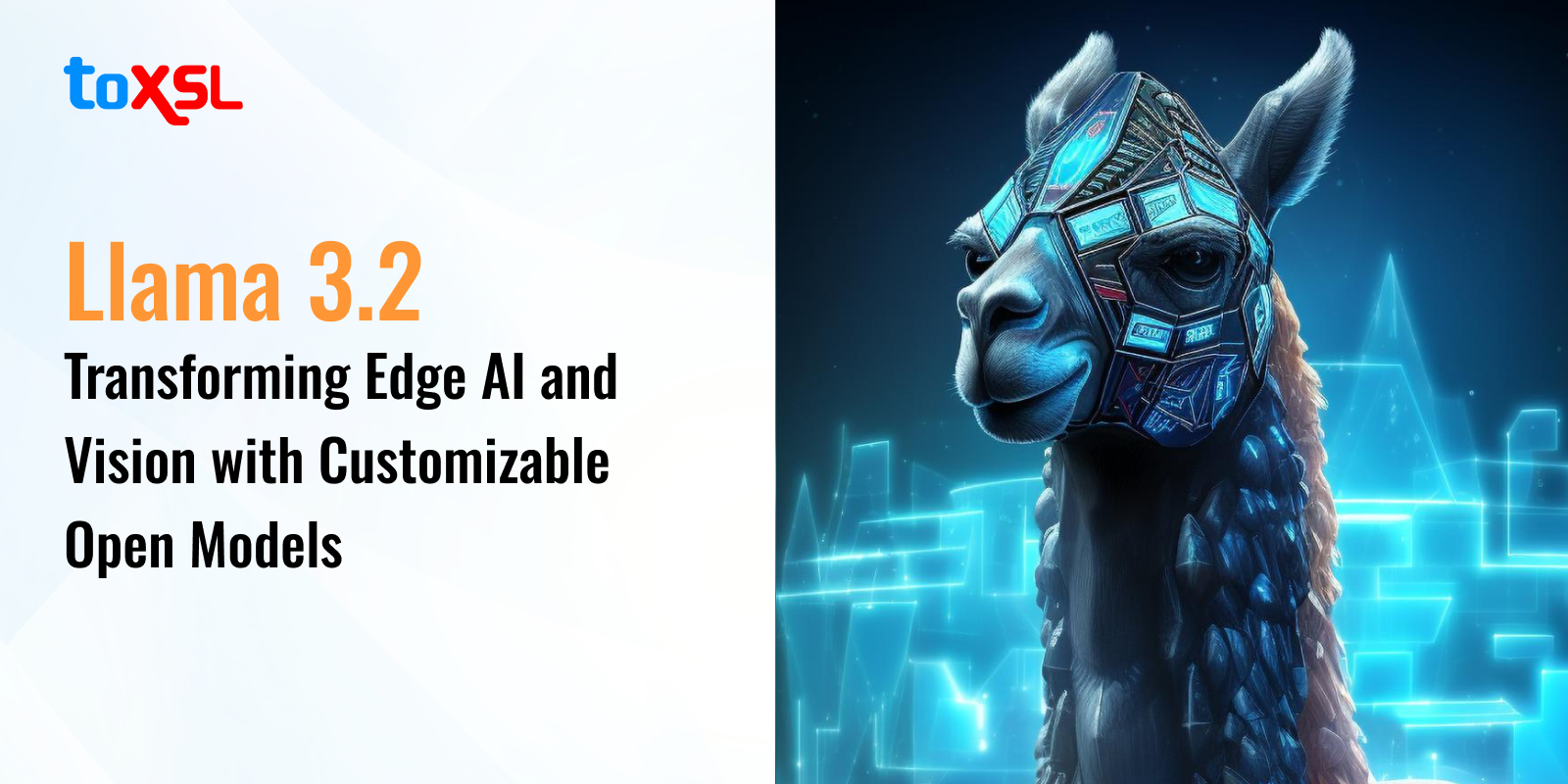- Apr 08, 2025
Share this post on:

Recently, at the Meta Connect event, Meta announced the launch of Meta's Llama 3.2, an innovative multimodal artificial intelligence model. This new version of the Llama series represents a major improvement, especially in edge AI and vision technology. With its introduction of customizable open models, Llama 3.2 not only enhances existing functionalities but also opens up new possibilities for various industries. This blog will explore the features, capabilities, and potential impacts of Llama 3.2, highlighting how it could transform edge AI and vision technology.
Overview of Llama 3.2
Llama 3.2 represents a new generation of multimodal models that integrate both text and image processing capabilities. Available in various sizes, including the powerful 90 billion parameter (90B) and 11 billion parameter (11B) models, Llama 3.2 is designed to handle complex reasoning tasks involving high-resolution images. These models are complemented by smaller text-only variants with 1 billion (1B) and 3 billion (3B) parameters, making them suitable for deployment on edge devices.
Key Features
Let us now explore the key features of the multimodal model:
1. Multi-Modal Capabilities: For the first time in the Llama series, the 11B and 90B models can process images as input alongside text. This functionality allows for a range of applications, from image captioning to visual question answering.
2. Customization: As open models, Llama 3.2 allows developers to fine-tune and adapt the models to meet specific needs, enhancing their versatility in real-world applications.
3. Lightweight Models: The smaller variants (1B and 3B) are optimized for edge computing environments, enabling AI applications on devices with limited computational resources.
4. Enhanced Performance: The instruction-tuned versions of these models have shown competitive performance on various benchmarks, rivalling some of the most advanced closed models available today.
The Importance of Edge AI
Edge AI refers to the deployment of AI algorithms on local devices rather than relying on centralized data centers. This approach offers several advantages:
• Reduced Latency: Processing data locally minimizes delays associated with data transmission to and from cloud servers.
• Increased Privacy: Keeping data on-device enhances user privacy by reducing exposure to external networks
• Cost Efficiency: Local processing can lower operational costs by reducing bandwidth usage and reliance on cloud services.
Llama's lightweight models are particularly suited for edge applications, enabling developers to create responsive AI solutions without significant infrastructure investments.
Applications of Llama 3.2
The introduction of Llama 3.2 opens up numerous possibilities across various sectors:
1. Healthcare
In healthcare settings, Llama 3.2 can assist in analyzing medical images such as X-rays or MRIs. Its ability to interpret visual data alongside textual information can enhance diagnostic accuracy and streamline workflows.
2. Retail
Retailers can leverage Llama 3.2 for personalized shopping experiences by analyzing customer images and preferences in real-time. This capability can improve product recommendations and customer engagement.
3. Education
Educational tools powered by Llama 3.2 can provide interactive learning experiences through visual aids, enhancing comprehension and retention among students.
4. Autonomous Systems
In robotics and autonomous vehicles, the multimodal capabilities of Llama 3.2 enable better decision-making by integrating visual inputs with contextual information for navigation and obstacle avoidance.
Technical Architecture
Llama 3.2 is built upon an optimized transformer architecture that supports both text generation and image processing tasks efficiently:
• Auto-Regressive Language Model: At its core, Llama 3.2 uses an auto-regressive model that predicts the next token based on previous context, allowing for coherent text generation.
• Fine-Tuning Techniques: The instruction-tuned versions utilize supervised fine-tuning (SFT) and reinforcement learning with human feedback (RLHF) to align outputs with user expectations effectively.
• Grouped Query Attention (GQA): This feature optimizes inference performance by allowing the model to handle multiple queries simultaneously, improving throughput in real-time applications.
Performance Benchmarks
Llama 3.2 has demonstrated impressive results across various benchmarks:
• The instruction-tuned Llama 3.2 90B Vision model has achieved scores comparable to OpenAI’s GPT-4o on tasks like chart understanding.
• The smaller Llama 3.2 11B Vision model outperformed competitors like Anthropic’s Claude series on visual question answering tasks.
These benchmarks highlight not only the capabilities of Llama 3.2 but also its potential as a viable alternative to existing closed models in the market.
Deployment Strategies
Llama 3.2 is designed for seamless integration into existing workflows across different platforms:
1. Cloud Services: Platforms like Google Cloud's Vertex AI and Amazon Bedrock offer managed services for deploying Llama models, allowing users to leverage powerful computing resources without extensive infrastructure setup.
2. Edge Devices: With its lightweight variants, organizations can deploy Llama 3.2 directly onto mobile phones or IoT devices, facilitating real-time processing and interaction.
3. Customization Tools: Developers can utilize tools provided by NVIDIA and other partners to optimize model performance further through techniques like low-rank adaptation (LoRA) or domain-specific fine-tuning.
Challenges and Considerations
While Llama 3.2 presents numerous advantages, there are challenges that developers must navigate:
• Resource Requirements: Despite being optimized for edge computing, deploying larger models may still require substantial computational resources.
• Data Privacy Concerns: While local processing enhances privacy, developers must ensure that sensitive data is handled appropriately within their applications.
• Model Maintenance: Continuous updates and improvements will be necessary to keep pace with advancements in AI technology and user expectations.
Future Directions
The release of Llama 3.2 signals a shift towards more accessible AI solutions that prioritize customization and multimodal capabilities:
• Continued Innovation: As Meta continues to refine its models, future iterations may introduce even more sophisticated functionalities tailored for specific industries or use cases.
• Community Engagement: Open models like Llama foster collaboration within the developer community, encouraging innovation through shared resources and knowledge exchange.
• Sustainability Focus: As AI technology evolves, there will be an increasing emphasis on developing sustainable practices that minimize environmental impact while maximizing efficiency.
Conclusion
Llama 3.2 stands out as a transformative force in edge AI and vision technology, offering customizable open models that empower developers across various sectors. Its multimodal capabilities combined with lightweight variants make it an attractive option for organizations looking to harness the power of AI while maintaining control over their data privacy and operational costs.
As we move forward into an era where AI becomes increasingly integrated into our daily lives, solutions like Llama 3.2 will play a crucial role in shaping how we interact with technology—making it more intuitive, responsive, and tailored to individual needs. The future is bright for those willing to embrace these advancements and explore the endless possibilities they present in revolutionizing our approach to artificial intelligence.
ToXSL Technologies is a leading mobile and web app development company with over 12 years in business. We have served more than 3000 clients globally, helping them expand their services. We integrate the latest technologies, such as artificial intelligence, the Internet of Things, and more, into our solutions, helping us create innovative next-gen solutions. Get in touch and leverage our services.
FAQs
1. What is Llama 3.2 and how does it enhance Edge AI?
Llama 3.2 is the latest version of Meta’s open-source language model, designed to power intelligent applications at the edge. It improves Edge AI by offering faster processing, lower latency, and advanced model customization – making real-time decision-making and deployment more efficient on devices with limited resources.
2. How does Llama 3.2 support computer vision tasks?
Llama 3.2 is optimized for vision-based applications by integrating language and image processing capabilities. It can handle tasks such as object detection, image captioning, and visual question answering, enabling developers to build smarter and more interactive vision systems directly on edge devices.
3. What makes Llama 3.2 models customizable?
Llama 3.2 offers open models that can be fine-tuned for specific use cases. Developers can adjust the model’s behavior, accuracy, and response based on the needs of their industry—whether it’s healthcare, manufacturing, retail, or smart cities—without needing massive infrastructure.












